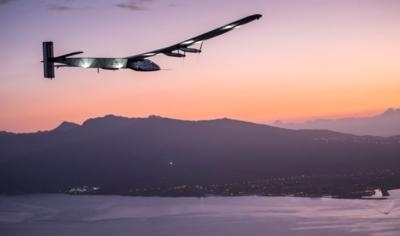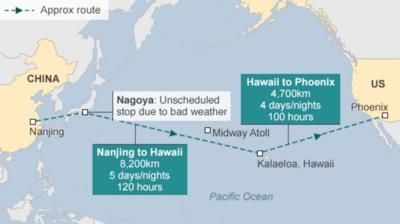Sat, Jul 18, 2015
Damage To The Airplane's Batteries Will Require Months To Correct
Despite the hard work of the Solar Impulse team to repair the batteries which overheated in the record breaking oceanic flight from Nagoya to Hawaii, the solar powered airplane of Bertrand Piccard and André Borschberg will stay in Hawaii until early spring 2016.

Following the longest and most difficult leg of the round-the-world journey which lasted 5 days and 5 nights (117 hours and 52 minutes), Solar Impulse will undergo maintenance repairs on the batteries due to damage brought about by overheating.
During the first ascent on day one of the flight from Nagoya to Hawaii, the battery temperature increased due to a high climb rate and an over-insulation of the gondolas. And while the Mission Team was monitoring this very closely during the flight, there was no way to decrease the temperature for the remaining duration as each daily cycle requires an ascent to 28,000 feet and descent for optimal energy management.
Overall the airplane performed very well during the flight. The damage to the batteries is not a technical failure or a weakness in the technology but rather an evaluation error in terms of the profile of the mission and the cooling design specifications of the batteries. The temperature of the batteries in a quick ascent / descent in tropical climates was not properly anticipated.
Irreversible damage to certain parts of the batteries will require repairs which will take several months. In parallel, the Solar Impulse engineering team will be studying various options for better cooling and heating processes for very long flights.

The University of Hawaii with the support of the Department of Transportation will host the airplane in its hangar at Kalaeloa airport. Post-maintenance check flights will start in 2016 to test the new battery heating and cooling systems. The round-the-world mission will resume early April from Hawaii to the west coast of the United States. From there Solar Impulse will cross the USA to JFK in New York before making the Atlantic crossing to Europe and then returning the point of departure in Abu Dhabi.
Solar Impulse is attempting a historic first of flying around the world only on solar energy. And while Solar Impulse has completed 8 legs, covering nearly half of the journey, setbacks are part of the challenges of a project which is pushing technological boundaries to the limits.
Solar Impulse will try to complete the first ever round-the-world solar flight in 2016 and this delay will in no way influence the overall objectives of this pioneering endeavour.
(Images from file provided by Solar Impulse)
More News
Aero Linx: International Federation of Airworthiness (IFA) We aim to be the most internationally respected independent authority on the subject of Airworthiness. IFA uniquely combi>[...]
Ultrahigh Frequency (UHF) The frequency band between 300 and 3,000 MHz. The bank of radio frequencies used for military air/ground voice communications. In some instances this may >[...]
A Few Questions AND Answers To Help You Get MORE Out of ANN! 1) I forgot my password. How do I find it? 1) Easy... click here and give us your e-mail address--we'll send it to you >[...]
From 2019 (YouTube Edition): Learning To Paint Without Getting Any On Your Hands PPG's Aerospace Coatings Academy is a tool designed to teach everything one needs to know about all>[...]
Also: Sustainable Aircraft Test Put Aside, More Falcon 9 Ops, Wyoming ANG Rescue, Oreo Cookie Into Orbit Joby Aviation has reason to celebrate, recently completing its first full t>[...]
 ANN's Daily Aero-Linx (05.06.25)
ANN's Daily Aero-Linx (05.06.25) ANN's Daily Aero-Term (05.06.25): Ultrahigh Frequency (UHF)
ANN's Daily Aero-Term (05.06.25): Ultrahigh Frequency (UHF) ANN FAQ: Q&A 101
ANN FAQ: Q&A 101 Classic Aero-TV: Virtual Reality Painting--PPG Leverages Technology for Training
Classic Aero-TV: Virtual Reality Painting--PPG Leverages Technology for Training Airborne 05.02.25: Joby Crewed Milestone, Diamond Club, Canadian Pilot Insurance
Airborne 05.02.25: Joby Crewed Milestone, Diamond Club, Canadian Pilot Insurance




